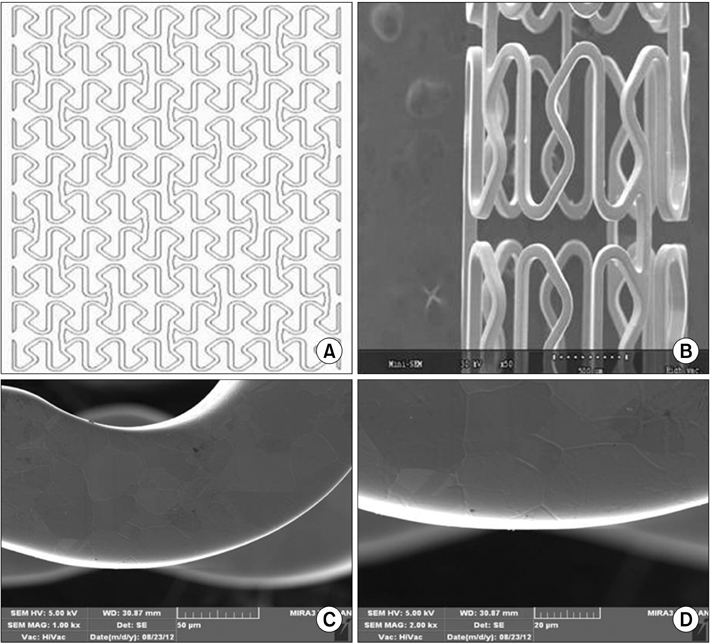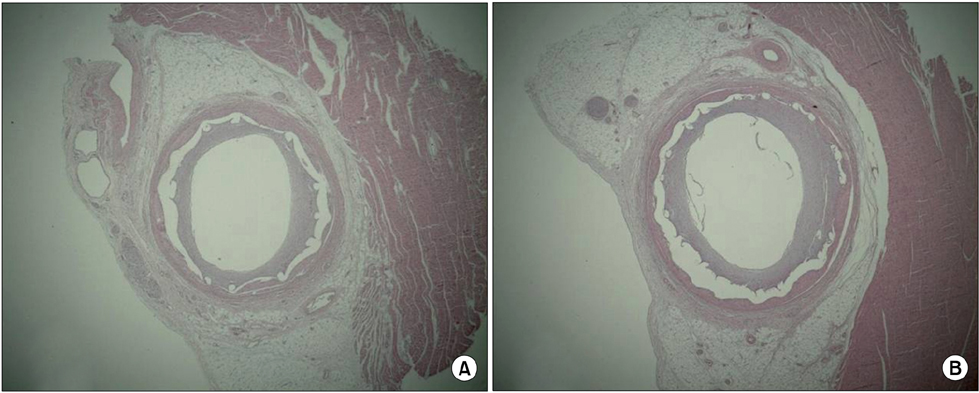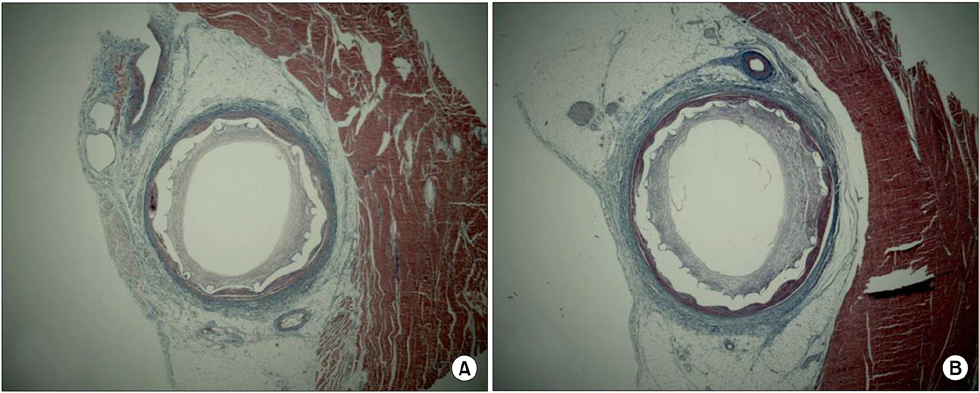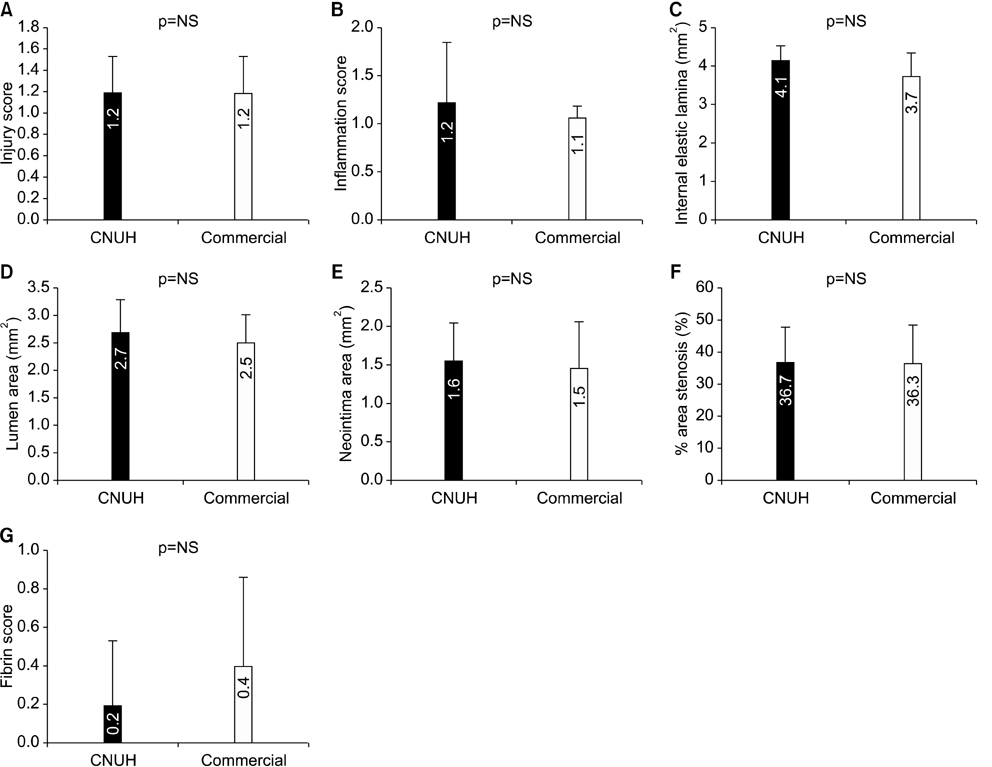Chonnam Med J.
2013 Apr;49(1):7-13. 10.4068/cmj.2013.49.1.7.
Mechanical and Histopathological Comparison between Commercialized and Newly Designed Coronary Bare Metal Stents in a Porcine Coronary Restenosis Model
- Affiliations
-
- 1The Heart Research Center of Chonnam National University Hospital Designated by Korea Ministry of Health and Welfare, Gwangju, Korea. myungho@chollian.net
- 2Chonnam National University Research Institute of Medical Science, Gwangju, Korea.
- 3Korea Cardiovascular Stent Institute, Jangsung, Korea.
- KMID: 2172170
- DOI: http://doi.org/10.4068/cmj.2013.49.1.7
Abstract
- The aim of this study was to compare the stent designed by Chonnam National University Hospital (designated as CNUH) with commercial cobalt-chromium coronary stent in a porcine coronary overstretch restenosis model. CNUH stent was subjected to mechanical performance tests. Pigs were randomized into two groups in which the coronary arteries (10 pigs, 10 coronaries in each group) had either CNUH stent or control commercial bare metal stent. Histopathologic analysis was assessed at 28 days after stenting. In mechanical performance tests, CNUH stent showed 2.65N, 35.1N, 0.52N, 1.94%, 4.29% in the flat plate radial compression, radial force, 3 point bending, Foreshortening and recoil test, respectively. There was no significant difference in the injury score, internal elastic lamina (IEL), lumen area, neointima area, percent area stenosis, inflammation score and fibrin score between the two groups (1.2+/-0.35, 4.1+/-0.41 mm2, 2.7+/-0.56 mm2, 1.6+/-0.47 mm2, 36.7+/-11.2%, 1.2+/-0.62, 0.2+/-0.34 in CNUH stent group vs. 1.2+/-0.38, 3.7+/-0.64 mm2, 2.5+/-0.49 mm2, 1.5+/-0.61 mm2, 36.3+/-12.17%, 1.1+/-0.12, 0.4+/-0.46 in commercial stent group, respectively). In the mechanical performance test, CNUH stent showed the moderated performance under the guideline of FDA. CNUH stent demonstrated similar histological reactions compared with commercial cobalt-chromium stent in a porcine coronary overstretch restenosis model.
MeSH Terms
Figure
Cited by 2 articles
-
Effect of Atorvastatin-Eluting Stents in a Rabbit Iliac Artery Restenosis Model
Kyung Seob Lim, Myung Ho Jeong, In Ho Bae, Jun-Kyu Park, Dae Sung Park, Jong Min Kim, Jung Ha Kim, Dong Lyun Cho, Doo Sun Sim, Keun-Ho Park, Young Joon Hong, Youngkeun Ahn
Chonnam Med J. 2013;49(3):118-124. doi: 10.4068/cmj.2013.49.3.118.Preclinical Evaluation of a Novel Polymer-free Everolimus-eluting Stent in a Mid-term Porcine Coronary Restenosis Model
Kyung Hoon Cho, Myung Ho Jeong, Dae Sung Park, Moonki Kim, JungHa Kim, Jun-Kyu Park, Xiongyi Han, Dae Young Hyun, Min Chul Kim, Doo Sun Sim, Young Joon Hong, Ju Han Kim, Youngkeun Ahn
J Korean Med Sci. 2021;36(40):e259. doi: 10.3346/jkms.2021.36.e259.
Reference
-
1. Moses JW, Leon MB, Popma JJ, Fitzgerald PJ, Holmes DR, O'Shaughnessy C, et al. SIRIUS Investigators. Sirolimus-eluting stents versus standard stents in patients with stenosis in a native coronary artery. N Engl J Med. 2003. 349:1315–1323.
Article2. Stone GW, Ellis SG, Cox DA, Hermiller J, O'Shaughnessy C, Mann JT, et al. TAXUS-IV Investigators. A polymer-based, paclitaxel-eluting stent in patients with coronary artery disease. N Engl J Med. 2004. 350:221–231.
Article3. Serruys PW, Ong AT, Piek JJ, Neumann FJ, van der Giessen WJ, Wiemer M, et al. A randomized comparison of a durable polymer Everolimus-eluting stent with a bare metal coronary stent: The SPIRIT first trial. EuroIntervention. 2005. 1:58–65.4. Gupta M, Budoff MJ. Drug-eluting stent versus bare-metal stent in acute ST-segment elevation myocardial infarction: a word of caution. J Invasive Cardiol. 2010. 22:159–160.5. Kaltoft A, Kelbaek H, Thuesen L, Lassen JF, Clemmensen P, Kløvgaard L, et al. Long-term outcome after drug-eluting versus bare-metal stent implantation in patients with ST-segment elevation myocardial infarction: 3-year follow-up of the randomized DEDICATION (Drug Elution and Distal Protection in Acute Myocardial Infarction) trial. J Am Coll Cardiol. 2010. 56:641–645.6. Di Lorenzo E, Sauro R, Varricchio A, Capasso M, Lanzillo T, Manganelli F, et al. Benefits of drug-eluting stents as compared to bare metal stent in ST-segment elevation myocardial infarction: four year results of the PaclitAxel or Sirolimus-Eluting stent vs bare metal stent in primary angiOplasty (PASEO) randomized trial. Am Heart J. 2009. 158:e43–e50.
Article7. Vorpahl M, Yazdani SK, Nakano M, Ladich E, Kolodgie FD, Finn AV, et al. Pathobiology of stent thrombosis after drug-eluting stent implantation. Curr Pharm Des. 2010. 16:4064–4071.
Article8. Kim W, Jeong MH, Hwang SH, Kim KH, Hong YJ, Ahn YK, et al. Comparison of abciximab combined with dalteparin or unfractionated heparin in high-risk percutaneous coronary intervention in acute myocardial infarction patients. Int Heart J. 2006. 47:821–831.
Article9. Ma GT, Li L, Wu XH. ST-elevation myocardial infarction caused by very late stent thrombosis due to drug-eluting stent fracture. Chin Med J (Engl). 2012. 125:2794–2796.10. de la Torre Hernández JM, Windecker S. Very late stent thrombosis with newer drug-eluting stents: no longer an issue? Rev Esp Cardiol (Engl Ed). 2012. 65:595–598.
Article11. Kastrati A, Dirschinger J, Boekstegers P, Elezi S, Schühlen H, Pache J, et al. Influence of stent design on 1-year outcome after coronary stent placement: a randomized comparison of five stent types in 1,147 unselected patients. Catheter Cardiovasc Interv. 2000. 50:290–297.
Article12. Kastrati A, Mehilli J, Dirschinger J, Dotzer F, Schuhlen H, Neumann FJ, et al. Intracoronary stenting and angiographic results strut thickness effect on restenosis outcome (ISAR-STEREO) trial. Vestn Rentgenol Radiol. 2012. (2):52–60.13. Briguori C, Sarais C, Pagnotta P, Liistro F, Montorfano M, Chieffo A, et al. In-stent restenosis in small coronary arteries: impact of strut thickness. J Am Coll Cardiol. 2002. 40:403–409.14. Douglas G, Van Kampen E, Hale AB, McNeill E, Patel J, Crabtree MJ, et al. Endothelial cell repopulation after stenting determines in-stent neointima formation: effects of bare-metal vs. drug-eluting stents and genetic endothelial cell modification. Eur Heart J. 2012. [Epub ahead of print].
Article15. Schwartz RS, Huber KC, Murphy JG, Edwards WD, Camrud AR, Vlietstra RE, et al. Restenosis and the proportional neointimal response to coronary artery injury: results in a porcine model. J Am Coll Cardiol. 1992. 19:267–274.
Article16. Schwartz RS, Edelman E, Virmani R, Carter A, Granada JF, Kaluza GL, et al. Drug-eluting stents in preclinical studies: updated consensus recommendations for preclinical evaluation. Circ Cardiovasc Interv. 2008. 1:143–153.17. Bocksch W, Pomar F, Dziarmaga M, Tresukosol D, Ismail O, Janek B, et al. Coroflex Blue Registry Investigators. Clinical safety and efficacy of a novel thin-strut cobalt-chromium coronary stent system: results of the real world Coroflex Blue Registry. Catheter Cardiovasc Interv. 2010. 75:78–85.
Article18. Sketch MH Jr, Ball M, Rutherford B, Popma JJ, Russell C, Kereiakes DJ. Driver Investigators. Evaluation of the Medtronic (Driver) cobalt-chromium alloy coronary stent system. Am J Cardiol. 2005. 95:8–12.
Article19. Joner M, Finn AV, Farb A, Mont EK, Kolodgie FD, Ladich E, et al. Pathology of drug-eluting stents in humans: delayed healing and late thrombotic risk. J Am Coll Cardiol. 2006. 48:193–202.20. Lim KS, Hong YJ, Hachinohe D, Ahmed K, Jeong MH, Kim JH, et al. Effect of a dual drug-coated stent with abciximab and alpha-lipoic Acid in a porcine coronary restenosis model. Korean Circ J. 2011. 41:241–247.
Article21. Hong YJ, Jeong MH, Song SJ, Sim DS, Kim JH, Lim KS, et al. Effects of ramiprilat-coated stents on neointimal hyperplasia, inflammation, and arterial healing in a porcine coronary restenosis model. Korean Circ J. 2011. 41:535–541.
Article22. Ahn YK, Jeong MH, Kim JW, Kim SH, Cho JH, Cho JG, et al. Preventive effects of the heparin-coated stent on restenosis in the porcine model. Catheter Cardiovasc Interv. 1999. 48:324–330.
Article23. Lim SY, Bae EH, Jeong MH, Kim JH, Hong YJ, Sim DS, et al. Effect of alpha lipoic acid in a porcine in-stent restenosis model. J Cardiol. 2009. 54:375–385.24. Kim W, Jeong MH, Cha KS, Hyun DW, Hur SH, Kim KB, et al. Effect of anti-oxidant (carvedilol and probucol) loaded stents in a porcine coronary restenosis model. Circ J. 2005. 69:101–106.
Article25. Kim W, Jeong MH, Kim KH, Sohn IS, Hong YJ, Park HW, et al. The clinical results of a platelet glycoprotein IIb/IIIa receptor blocker (abciximab: ReoPro)-coated stent in acute myocardial infarction. J Am Coll Cardiol. 2006. 47:933–938.
Article26. Bae IH, Park IK, Park DS, Lee H, Jeong MH. Thromboresistant and endothelialization effects of dopamine-mediated heparin coating on a stent material surface. J Mater Sci Mater Med. 2012. 23:1259–1269.
Article27. Song SJ, Jung KW, Park YJ, Park J, Cho MD, Jeong MH, et al. Nitrogen-doped TiO2 films as drug-binding matrices for the preparationof drug-eluting stents. J Mater Chem. 2011. 21:8169–8177.
Article28. Song SJ, Park YJ, Park J, Cho MD, Kim JH, Jeong MH, et al. Preparation of a drug-eluting stent using a TiO2 film deposited by plasma enhanced chemical vapour deposition as a drug-combining matrix. J Mater Chem. 2009. 20:4792–4801.
Article29. Sim DS, Kwon JS, Kim YS, Chung HC, Hong YJ, Park HW, et al. Experience with endothelial progenitor cell capturing aptamers for coating of intracoronary stents in a porcine model. Tissue Eng Regen Med. 2009. 6:555–561.30. Che HL, Bae IH, Lim KS, Song IT, Lee H, Muthiah M, et al. Suppression of post-angioplasty restenosis with an Akt1 siRNA-embedded coronary stent in a rabbit model. Biomaterials. 2012. 33:8548–8556.
Article
- Full Text Links
- Actions
-
Cited
- CITED
-
- Close
- Share
- Similar articles
-
- Is There a Benefit of Drug-Eluting Stents Rather than Bare Metal Stents in Large Coronary Artery Lesions?
- Spontaneous regression of neointimal hyperplasia in a patient who underwent percutaneous coronary intervention with a bare metal stent
- Very Late In-Stent Restenosis in Bare Metal Stents: A Case Report
- Inhibitory Effect of Double Coating with Echinomycin and Hydrophobic Heparin in a Porcine Coronary In-Stent Restenosis Model
- Systemic drug therapy and restenosis after drug-eluting stent implantation





